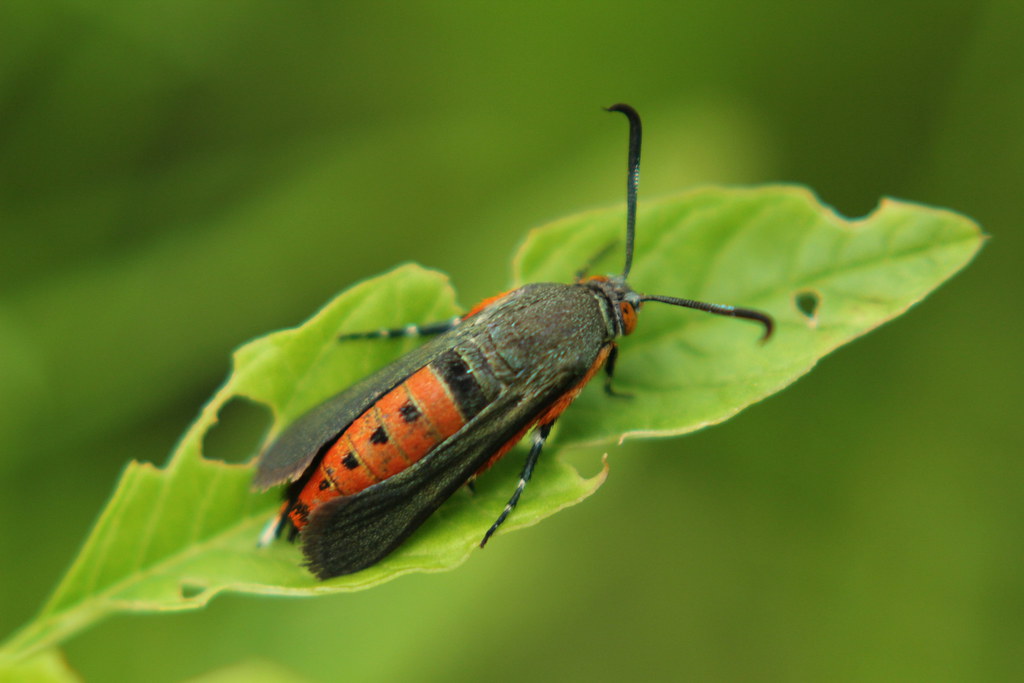June Gardening To-Dos

Squash Vine Borer Moth
Welcome to summer! June ushers in consistent warm nights and during the day the sun shines with more intensity. Be sure to apply sun screen, wear a hat, and keep water with you. ‘Tis the season for diligently avoiding heat exhaustion and sunstroke. See below for other things that should be on your June gardening to-dos.
Things to Do in the Garden for June |
|
FERTILIZE |
Add compost to annuals and vegetables, fertilize only if needed. Scratch the fertilizer into the top layer of soil and water deeply to quickly move the nutrients into solution. Alternatively, use a liquid fertilizer and a siphon mixer to deliver through your irrigation system. Provide supplemental iron through foliar applications or drenches, if needed, before daytime temperatures exceed 80°F. Dr. Larry Stein from Texas A&M University recommends EDDHA water soluble chelated iron because it performs the best in alkaline soils. |
WATER |
Irrigate deeply and as infrequently as you can to encourage deep roots. Keep an eye on container grown plants. As the temperatures rise and rain diminishes, these plants may require daily watering. |
TRANSPLANT |
Time to take a vacation from adding new perennials, grasses, and trees. Wait until fall. |
SOIL |
Pull back mulch, apply compost, then replace mulch to retain soil moisture. |
LAWNS |
Stop fertilizing to prevent brown patch and take-all root rot. Raise mower settings to reduce turf stress. Water in the morning. Avoid weed killers once temperatures exceed 85°F |
DISEASES/PESTS TO LOOK FOR |
Monitor the sunny areas of your lawn for chinch bugs. Spot treat scale and mealy bugs with horticultural oil, being careful not to spray oil on leaves. Spider mites tend to show up as the days get hotter and drier. To check for mites, hold a white paper plate underneath a leaf and tap a few times. Dislodged mites will fall onto the plate and look like tiny specks crawling around. Though these tiny pests are hard to see without the aid of magnification, once they are present, the top surface of the leaves will have a pale, stippled appearance. Organic controls for spider mites include horticultural oils, insecticidal soap and sulfur dust. Once you have them you will need to treat regularly to keep them under control. They can also be controlled with a strong spray of water to the underside of the leaves, repeated every 3-5 days. Once their population explodes, you may see a fine webbing develop under the leaves. At that point it is too late to treat, and the affected plant should be removed from the garden. Use the same water blast technique on the undersides of leaves to control aphids, and whiteflies. |
MAINTENANCE |
Deadhead flowers and spent foliage. Remove fruiting canes from blackberries when last berry is harvested. Summer prune shrubs and trees (except Oaks) to remove damaged or dead wood if found. Replenish mulch if needed. Train vines and climbing roses up a trellis. Visit the vegetable garden daily to monitor for pests and pick crops before they become overgrown. |
IN THE VEGETABLE GARDEN |
Travis County Master Gardener Patty Leander battles squash vine borers and recommends using micromesh for protection against the moth. Dig potatoes when the tops turn yellow and start to die back. Harvest ripe vegetables before spraying plants with any pesticide or fertilizer, whether organic or synthetic. Always read the label for instructions on mixing, dilution, how often to spray, or if there is a waiting period after spraying. Bush varieties of green beans generally produce a concentrated set of pods over a 2-4 week period before petering out. As plants begin to decline, pull them out and replace with heat-tolerant Southern peas, long beans, okra or sweet potatoes. Harvest onions and garlic when tops fall over. Cure in a warm, dry location for a few days before storing. It’s time to plant cover crops in fallow beds, Patty recommends cowpeas or buckwheat. Start tomato seeds in pots early in the month if you want to have transplants ready for the garden in mid-July. Because the fall growing season is shorter, it’s best to stick with early-maturing, determinate varieties. See the full Vegetable Garden Planting Guide (Español, 繁体中文) and Vegetable Varieties for Central Texas. |
Your June Indoor Gardening Checklist |
|

Monitor plants for too much sun |
|
FERTILIZE |
Continue to fertilize your houseplants twice monthly, or as indicated by the plant label. |
WATER |
If your plants are outside, they will require more water but be careful not to overwater. Houseplant roots are usually in the bottom two thirds of the pot, so only water when the bottom of the pot is dry. For a 6-inch pot, stick your index finger about 2 inches into the soil (approximately to the second joint of your finger). If the soil feels damp, don’t water. Keep repeating the test until the soil is barely moist at the 2-inch depth. For smaller pots, 1 inch into the soil is the proper depth to measure. |
HUMIDITY |
Depending on the weather, you may need to start using humidity trays and humidifiers for indoor plants. |
FOLIAGE CARE |
Keep dust off of plant leaves with a soft cloth. |
DISEASES/PESTS TO LOOK FOR |
Inspect undersides of leaves for pests. |
MAINTENANCE |
Remove any dead, damaged or dying leaves. Remember that the sun changes position as the season progresses. Make sure plants you’ve moved outdoors are not getting scorched. |
 As a contributor to Central Texas Gardener (CTG), Daphne Richards, County Extension Agent-Horticulture, answers questions and shares knowledge on new and tried & true plants for Central Texas. Check out some of our favorites for June!
As a contributor to Central Texas Gardener (CTG), Daphne Richards, County Extension Agent-Horticulture, answers questions and shares knowledge on new and tried & true plants for Central Texas. Check out some of our favorites for June!
 Fire Ants in Compost Pile|Daphne Richards|Central Texas Gardener
Fire Ants in Compost Pile|Daphne Richards|Central Texas Gardener
 Tomato Blossom End Rot|Daphne Richards|Central Texas Gardener
Tomato Blossom End Rot|Daphne Richards|Central Texas Gardener
 Fern Spores|Daphne Richards|Central Texas Gardener
Fern Spores|Daphne Richards|Central Texas Gardener
 Why squash flowers and fruits fall off |Daphne Richards|Central Texas Gardener
Why squash flowers and fruits fall off |Daphne Richards|Central Texas Gardener
Get Growing!
President Thomas Jefferson said “The greatest service which can be rendered any country is to add a useful plant to its culture.” This handy reference will help you discover which useful plants you can add to your own garden and serve as a guide for each months to-dos: January, February, March, April, May, June, July, August, September, October, November, and December.

